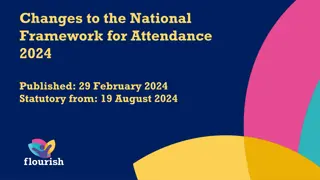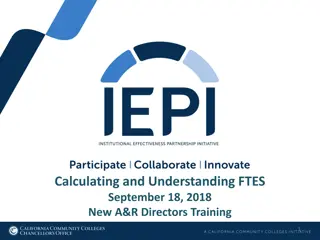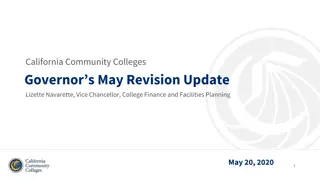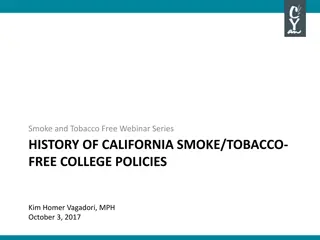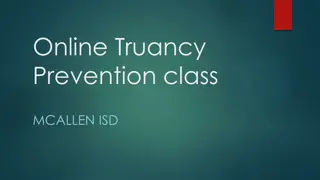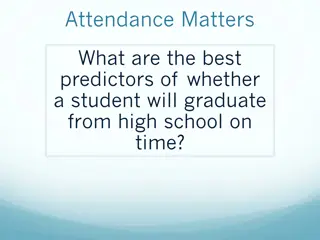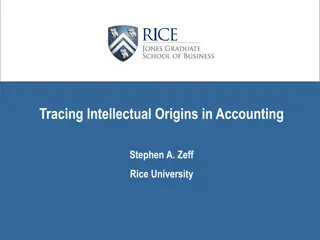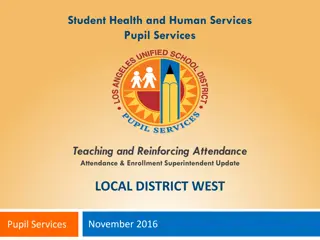Understanding California Community Colleges Attendance Accounting Basics
Explore the importance of discussing attendance accounting basics for California Community Colleges, especially in transitioning to a new academic calendar structure. Discover how scheduling guidelines are influenced by attendance accounting principles and regulations provided by the state. Uncover the origins of meeting lengths and frequencies in relation to attendance accounting provisions outlined in the Student Attendance Accounting Manual. Gain insights into the sources of authority governing attendance accounting for the CCC.
Download Presentation

Please find below an Image/Link to download the presentation.
The content on the website is provided AS IS for your information and personal use only. It may not be sold, licensed, or shared on other websites without obtaining consent from the author. Download presentation by click this link. If you encounter any issues during the download, it is possible that the publisher has removed the file from their server.
E N D
Presentation Transcript
Alternative Academic Calendar Project Attendance Accounting Basics JOHN MULLEN, CONSULTANT
2 Why should we discuss the basics of California Community Colleges attendance accounting? Alternative Academic Calendar Project A change from the traditional 17.5-week semester academic calendar to one with two 16-week semesters would require rescheduling classes following prescribed guidelines issued by the State Chancellor s Office. ATTENDANCE ACCOUNTING BASICS Those guidelines are based on the attendance accounting principles in the Education Code and Title 5. This presentation substantially explains those principles, leading to a better understanding of the seemingly arbitrary guidelines that must be carefully followed to avoid costly audit exceptions.
3 As an example of the scheduling guidelines, note these options for a full- semester 3-unit lecture course on the example 16-week calendar: Alternative Academic Calendar Project Two meetings per week of 1 hour and 25 minutes, or One meeting per week of 3 hours and 10 minutes SCHEDULING A 3-UNIT LECTURE COURSE On a traditional calendar, the course would typically be scheduled with two meetings per week of 1 hour and 15 minutes, or one meeting per week of 3 hours.
4 Another example shows a typical schedule for a full-semester 5-unit lecture/lab course on the 16-week calendar: Alternative Academic Calendar Project Two lecture meetings per week of 1 hour and 25 minutes Two lab meetings per week of 3 hours and 10 minutes SCHEDULING A 5-UNIT LECTURE/LAB COURSE On a traditional calendar, course would typically be scheduled with two lecture meetings per week of 1 hour and 15 minutes and two lab meetings per week of 2 hours and 50 minutes
5 Where did those meeting lengths and numbers of meetings per week come from? They are direct consequences of the attendance accounting provisions set forth in the Student Attendance Accounting Manual (SAAM) issued by the State Chancellor s Office. Alternative Academic Calendar Project ATTENDANCE ACCOUNTING REGULATIONS Let s go behind the curtains and learn the attendance accounting basics that tell the story.
6 Attendance Accounting for the CCC Sources of Authority Alternative Academic Calendar Project California Legislature Education Code ATTENDANCE ACCOUNTING FOR THE CCC Board of Governors of the California Community Colleges Title 5 of the California Code of Regulations
7 Full-Time Equivalent Student 1 FTES = Alternative Academic Calendar Project 1 student 15 hours per week 2 semesters of 17.5 weeks (3 quarters of 11.67 weeks) FULL-TIME EQUIVALENT STUDENT = 525 contact hours
8 FTES Calculation Clock Hour Class Hour Passing time/break Partial class hour Multiple hour class Alternative Academic Calendar Project FTES CALCULATION
9 Clock Hour A 60-minute time frame that may begin at any time Examples: Alternative Academic Calendar Project 0800 to 0900 0810 to 0910 0820 to 0920 CLOCK HOUR
10 Class Hour A period of not less than 50 minutes of scheduled instruction or examination There can be only one class hour in each clock hour, except for multiple hour classes A class hour is commonly called a contact hour or student contact hour. Alternative Academic Calendar Project CLASS HOUR
11 Passing Time/Break Each clock hour is composed of one class hour segment and a segment referred to as passing time or a break. Alternative Academic Calendar Project PASSING TIME/ BREAK No additional attendance may be claimed for the 10-minute segment, except for multiple-hour classes.
12 Multiple Hour Class Each 50 minutes exclusive of breaks is a class hour. A partial class hour beyond the last full clock hour is counted from the 51st minute of the last full clock hour. Alternative Academic Calendar Project MULTIPLE HOUR CLASS
13 Multiple Hour Class Example: Alternative Academic Calendar Project 7:00 p.m. to 10:05 p.m. PCH: 9:51 10:05 = 15 min. 15/50 = 0.3 Total Contact Hours: 3.3 MULTIPLE HOUR CLASS
14 Calculate the Contact Hours Class meets from 0900 to 0950 0900 to 1000 0900 to 1005 0900 to 1050 0900 to 1100 0900 to 1105 0900 to 1130 Contact hours 1.0 1.0 1.3 2.0 2.0 2.3 2.8 Alternative Academic Calendar Project CALCULATE THE CONTACT HOURS
15 Alternative Academic Calendar Project CONTACT HOURS COMPUTATION CHART
16 Attendance Accounting Methods An appropriate attendance accounting method must be associated with each class section. How the instruction is provided for a particular class determines the attendance accounting method(s) that may be used for that section. Whether the class meetings are synchronous or asynchronous is a major factor in choosing the right attendance accounting method for a class. Alternative Academic Calendar Project ATTENDANCE ACCOUNTING METHODS
17 Synchronous Instruction Instruction is synchronous when the instructor and students meet together at the same time. Alternative Academic Calendar Project They may meet together either in person in a classroom, laboratory, or other physical setting, or virtually using online technology that permits two-way communication. SYNCHRONOUS INSTRUCTION However class meetings are organized, the instructor must be able to determine the presence or absence of each enrolled student at each class meeting.
18 Asynchronous Instruction Instruction is asynchronous when it is provided to students at different times. Many distance education classes allow students to receive instruction at times of their choosing. Alternative Academic Calendar Project Some classes are taught with a combination of synchronous and asynchronous instruction. In determining the appropriate attendance accounting method for a class, if any portion of the instruction (not homework) is provided asynchronously, the instruction for the class section as a whole is considered to be asynchronous. ASYNCHRONOUS INSTRUCTION
19 Choosing an Appropriate Attendance Accounting Method For classes with synchronous instruction: Weekly Student Contact Hour Daily Student Contact Hour Actual Hours of Attendance (Positive Attendance) For classes with asynchronous instruction: Alternative Attendance Accounting Method (Independent Study/Work Experience) Noncredit Distance Education Alternative Academic Calendar Project ATTENDANCE ACCOUNTING METHODS
20 Weekly Student Contact Hour Method (Weekly Census) Primary terms only; synchronous instruction only Course coterminous with primary term Must meet regularly every week of the term Same number of contact hours each week including TBA hours No deductions for holidays Alternative Academic Calendar Project WEEKLY STUDENT CONTACT HOUR METHOD
21 Census Week The week nearest to 20% of the number of weeks in the primary term Census date is Monday of census week If that Monday is a holiday, census date is the following day Alternative Academic Calendar Project WEEKLY STUDENT CONTACT HOUR METHOD
22 Term Length Multiplier TLM is the number of weeks in primary term with at least three days of instruction and/or examination The term length multiplier for each college is set by the CCC Chancellor s Office based on the college s academic calendar Maximum TLM: 17.5 for semesters 11.67 for quarters Alternative Academic Calendar Project WEEKLY STUDENT CONTACT HOUR METHOD
23 FTES Calculation Multiply Census Week WSCH by the TLM and divide by 525 Alternative Academic Calendar Project Example: Class meets 3 hours/week 30 students enrolled on Census Day TLM = 17.5 FTES = (3x30 x 17.5) / 525 = 3.00 FTES = (CWSCH x TLM) / 525 WEEKLY STUDENT CONTACT HOUR METHOD
24 FTES Calculation With a compressed academic calendar on the semester system, the TLM is less than 17.5, but the number of contact hours per week (CWSCH) of a typical course is greater than under a traditional calendar. Alternative Academic Calendar Project WEEKLY STUDENT CONTACT HOUR METHOD Following the CCCCO scheduling guidelines, the resulting FTES = (CWSCH x TLM) / 525 is generally about the same as or slightly higher than under a traditional calendar.
25 Let s return to this example of the scheduling guidelines, noting these options for a full-semester 3-unit lecture course on the example 16-week calendar: Alternative Academic Calendar Project Two meetings per week of 1 hour and 25 minutes, or One meeting per week of 3 hours and 10 minutes SCHEDULING A 3-UNIT LECTURE COURSE On a traditional calendar, the course would typically be scheduled with two meetings per week of 1 hour and 15 minutes, or one meeting per week of 3 hours.
26 Where did these come from? Two meetings per week of 1 hour and 25 minutes, or One meeting per week of 3 hours and 10 minutes Alternative Academic Calendar Project Explanation: Target total contact hours: 54 SCHEDULING A 3-UNIT LECTURE COURSE Target contact hours per week: 54/16 = 3.375 Guideline rounds 3.375 to 3.4 Two meetings/week of 1.7 contact hours One meeting/week of 3.4 contact hours
27 Alternative Academic Calendar Project CONTACT HOURS COMPUTATION CHART
28 Daily Student Contact Hour Method (Daily Census) Synchronous instruction only Course meets five or more days Meets the same number of hours on each scheduled day, including any TBA hours NOT coterminous with primary term No hours counted for holidays Alternative Academic Calendar Project DAILY STUDENT CONTACT HOUR METHOD
29 Census Day The day of the class meeting that is nearest 20% of the number of days the course is scheduled to meet When the census day falls on the first day the class meets, census is taken on the second day. Alternative Academic Calendar Project DAILY STUDENT CONTACT HOUR METHOD
30 Course Length Multiplier CLM is the number of days the course is scheduled to meet (i.e., the number of class meetings). Alternative Academic Calendar Project DAILY STUDENT CONTACT HOUR METHOD
31 FTES Calculation Multiply Census Day DSCH by the Course Length Multiplier and divide by 525 Alternative Academic Calendar Project FTES = (CDSCH x CLM) / 525 Example: Class meets 2 hours per day 30 students enrolled on Census Day Course meets on 24 days FTES = (2 x 30 x 24) / 525 = 2.74 DAILY STUDENT CONTACT HOUR METHOD
32 TBA (To Be Arranged) Hours Ensure that TBA hours for Weekly Census classes are required each week, not as a total number of hours for the term. Alternative Academic Calendar Project Ensure that TBA hours for Daily Census classes are required each day, not as a total number of hours per week or term. TBA HOURS
33 TBA (To Be Arranged) Hours Ensure that attendance records are kept and that no TBA hours are reported for Weekly or Daily Census classes for students who have documented zero hours by census. Alternative Academic Calendar Project TBA HOURS
34 Actual Hours of Attendance Method (Positive Attendance) Based on actual count of enrolled students present at each class meeting; synchronous instruction only Courses meeting fewer than five days Courses irregularly scheduled with respect to the number of days per week or the number of hours on scheduled days All in-person noncredit courses Alternative Academic Calendar Project POSITIVE ATTENDANCE
35 FTES Calculation Divide total hours of actual attendance by 525 FTES = PAH / 525 Alternative Academic Calendar Project POSITIVE ATTENDANCE
36 Scheduling Exercise #1 ENGL 107 3 units (54 lecture hours) College has a traditional calendar with two 18-week semesters. Synchronous instruction Full-term section meeting MWF beginning at 8:00 am. Most appropriate attendance accounting method: Weekly Census Each meeting begins at 8:00 am and ends at 8:50 am Alternative Academic Calendar Project SCHEDULING EXERCISES
37 Scheduling Exercise #2 ENGL-107 3 units (54 lecture hours) Calendar has two 18-week semesters. Synchronous instruction 9-week section meets MTTh at 9:00 am. No holidays within the 9-week period Attendance method: Daily Census 54 hours/27 meetings = 2 hours per meeting Each meeting ends at 10:50 am Alternative Academic Calendar Project SCHEDULING EXERCISES
38 Scheduling Exercise #3 ENGL-107 3 units (54 lecture hours) Synchronous instruction 6-week summer session section MTWTh beginning at 10:00 am. The July 4 holiday falls on a scheduled meeting day. Attendance method: Daily Census 54 hours/23 meetings = 2.3 hrs/mtg Each meeting ends at 12:05 pm Alternative Academic Calendar Project SCHEDULING EXERCISES
39 Scheduling Exercise #4 BIOL 103A (4 units, 54 hrs lec, 54 hrs lab) Synchronous instruction; 6-week summer intersession Schedule proposed by Biology Dept: Lecture MTWTh 8:45 11:00 Lab MTW 11:00 14:00 This configuration does not qualify for Daily Census since the meeting times vary on different days. Would have to be Positive Attendance, and that is undesirable. Alternative Academic Calendar Project SCHEDULING EXERCISES
40 Scheduling Exercise #4 BIOL 103A Six-week Summer Session Daily Census Alternative Academic Calendar Project Catalog: 54 hours lec, 54 hours lab Total hours: 108 Meeting days: 23 108/23 = 4.7 or 4 hours, 25 minutes SCHEDULING EXERCISES Solution: MTWTh 8:00 12:25 23 * 4.7 = 108.1 contact hours, distributed between lecture and lab
41 Alternative Attendance Accounting Methods (Independent Study/Work Experience) Alternative Academic Calendar Project Asynchronous instruction Alternative Attendance Accounting WSCH Methodfor courses coterminous with primary term ALTERNATIVE ATTENDANCE ACCOUNTING METHODS Alternative Attendance Accounting DSCH Methodfor all other courses
42 FTES Calculation Multiply number of students enrolled as of census by the number of weekly contact hours ; multiply by the Term Length Multiplier; divide by 525. Alternative Academic Calendar Project ALTERNATIVE ATTENDANCE ACCOUNTING METHODS FTES = (#Students * WCH * TLM)/525
43 Noncredit Distance Education Method There is one additional attendance accounting method that we will not cover in detail in this presentation in view of its complexity and limited use. Alternative Academic Calendar Project The Alternative Attendance Accounting Procedure Noncredit is used for noncredit distance education courses. It is the only procedure that can be used for distance education courses taught asynchronously. NONCREDIT DISTANCE EDUCATION METHOD
44 Curriculum Alignment CONSISTENCY is the magic word: Catalog Course Outlines of Record Schedule of Classes Printed Version Online Class Listings Class Syllabi Alternative Academic Calendar Project CURRICULUM ALIGNMENT
45 Frequently Observed Errors Hybrid courses inappropriately assigned to the Weekly Census or Daily Census method Daily Census courses with weekly lab hours Summer courses assigned Weekly Census Summer courses reported in the wrong year, or reported in both years Catalog hours reported rather than Schedule hours TBA hours irregularities Alternative Academic Calendar Project FREQUENTLY OBSERVED ERRORS
46 Questions? Contact: Alternative Academic Calendar Project John Mullen | Senior Consultant Chabot-Las Positas Community College District Educational Services & Student Success jmullen@clpccd.org Telephone 650.533.6850 QUESTIONS










